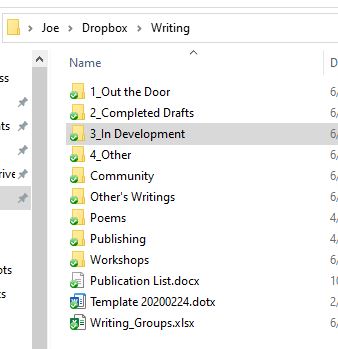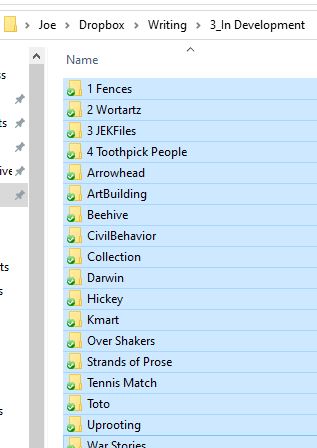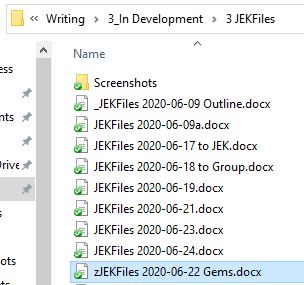Your Computer Is Your Friend
All too often, I hear writers complain that their hard drives are a mess, that important files keep disappearing into the digital miasma of those hard drives. Hearing them talk, I imagine the Starship Enterprise cruising an inky star field, stars strewn at random and broadcast like seeds of creation across an inky backdrop.
Organizing paper is a visual, tactile experience for which our binocular vision and opposable thumbs are superbly qualified: books on shelves, loose leaves in filing cabinets. To find something, you scan the shelves with your eyes or paw through the drawers with your hands.
A hard drive, on the other hand, is an opaque, unopenable object. If you do find a way to open it up, all you’ll see inside is a magnetic metal disk that no more resembles your writings than a vinyl record’s grooves resemble the songs they record.
A computer, however, does at least two things that office furniture can’t. Its built-in software is designed not only to automatically alphabetize your files but also to constantly index them in order to keep track of where each one is located. Imagine a bookcase that magically shelves and reshelves your books in correct alphabetical order or a filing cabinet that creates, keeps current, and displays on demand a meticulous directory of its contents. Happens in Hogwarts maybe, but not in any muggle’s workspace.
You can take advantage of your hard drive’s built-in organizational features in order to take control of your digital writing life. To that end, this essay provides some tips that may help you transform your computer from a cursed enemy to your best friend and ally.
Hierarchical Structure and Other Geek Concepts
Regardless of whether you use a PC or a Mac, computers organize their contents using a hierarchical file structure, which is geek-speak for “start at the top and work your way down.” The structure is composed of a cascading system of folders, each of which can hold not only files but also other folders, each of which contains more files and folders, and so on, propagating downward like the rings of Dante’s Hell, or like an orderly descent into the sub-subbasement where a university department keeps its graduate students–which could be the same thing as Dante’s Hell, depending on department politics.
Let’s enter my computer’s hard drive and “navigate” (as we geeks say) down to the level where my digital writing life resides. It’s not that far. In fact, let’s just slide down the banister, it’s quicker. Whee! Plop. Here we are.

The screenshot above is from a PC program called File Explorer (ergo “navigation”). The similar program on Macs is called Finder. The image reveals the contents of a folder called “Writing,” where I store all my writing-related files. The four folders at the top of the list are where I store all my actual writing, mostly short stories. The lower five folders, which we won’t go into here, contain files related mostly to the “social side” of my writing life: workshops, writing groups, and also poems, which I only write when I am either depressed or hitting the “enter” key too often after having had too much coffee.
I divvy my stories into four folders that are numbered in descending order from “Out the Door” (meaning they are submitted or have been accepted for publication) to “Other,” a voluminous slush pile of false starts, promising leads, and rough diamonds that I may someday try cutting. These folders are numbered as well as named. Numbering and naming them takes advantage of my computer’s obsession for sorting folders and files numerically and alphabetically. The numbered folders that contain my actual writing automatically sort at the top of the stack, listed in order of their readiness for submission. Therefore, when I open “Writing,” my friend the computer immediately reminds me of my priorities.
Naming Files
Now let’s find where the files for this blog post are stored. All the files for this blog post are stored under “3 In Development” because, as I write, the piece isn’t yet completed. As you can see in the screenshot below, I currently have 18 works in progress. That doesn’t mean I’m actually making progress on them. Most are just parked here, in a place I can find them if I ever decide to get back to them. Kind of like junk cars in your grease monkey uncle’s yard.

Each folder contains the files for a single story (or essay), identified by brief mnemonic nicknames. Note that the stories that I’m currently working on are numbered so that they always display at the top of the list, but not just for convenience in finding them. Putting them at the top keeps them readily at hand and is also a visual reminder of where my priorities lie. Tactile, visual: I’ve trained my computer to stroke my deep, primal urges. Good computer.
Okay, so let’s have a look inside the “JEK Files.” This folder contains a subfolder (“Screenshots”) where I’m storing JPGs captured off my monitor for use in this piece. The nine Word documents include drafts of this piece, with an outline at the top and a collection of outtakes (i.e., “gems”) I don’t want to get rid of just yet.

The file names all include the essay’s “nickname,” which may seem unnecessary since the files are already in a folder of that name, but here’s the reason. At any time during a cut-and-paste, drag-and-drop, or file-save-as, a slight slip of the mouse could fling a file somewhere I didn’t intend. Two days later, when I find my latest and greatest missing, I can either rant and rave so loudly that the neighbors call the cops or I can take a deep breath and use File Explorer’s search function. Your computer–it files, it sorts, it strokes your primal urges, and it does search and rescue. What a machine!
After the story’s nickname comes the date on which the file was created. Using the format YYYY/MM/DD ensures that your drafts are displayed in the order you wrote them. By simply looking at the list, I can see that I started composing this post on June 9th and now it’s June 24th. Fifteen frigging days! The 2020-06-24 draft had better be the final one or the JEK of JEK Files will unleash her dog of war, Rosie, on me. Rosie: Fifteen but ferocious.
Sometimes it’s handy to add a tag to the file name. The June 17th draft, “to JEK,” is the file I sent Jessica for a first look. “To Group” is the draft I workshopped with my writing group (one which I could have also tagged “ripped to shreds”). My outline is tagged, but is also prefixed with an underscore, a special character that, like numbers, ensures that it sorts at the top of the list. A “z” prefix added to the Gems file forces it to sort at the bottom, out of the way. Prefixes are yet another way to keep my computer mindful of the way I like things organized, like Quixote training Sancho in the needs of a knight errant.
Ah, faithful Sancho! On, Rosinante! To the next section!
Consistency
Now for the hard part. Steel yourself. For your file and folder naming conventions to work, rigorous consistency is required. Your computer, diligent though she be, could care less what you name a file; she just puts it wherever your mouse or touchscreen instructs. It’s up to you to follow your own rules. Yes, I know–consistency does not come easily to your free-spirited, creative writer’s genius. But the alternative–wasting hours searching for files you’ll never see again–is far worse. Once you’ve developed the habit, your computer does the rest by building and maintaining the pathways to all your files and then leading you to them: the GPS Lady of the digital streets and alleys of your writing life.
The Takeaway and Final Thoughts
In organizing your digital writing life, you can make your computer your best friend and ally–a virtuous virtual Sancho Panza. Your computer comes with built-in software that automatically files, alphabetizes, and indexes your work, keeping track for you where each file is located on your hard drive. It is up to you to take advantage of these features in order to take control of your digital writing life.
In this essay, I’ve offered the following suggestions for taking such control:
- Keep your writing-related items in one or just a few folders.
- Within your master folder(s), create separate folders for each of your stories (or poems or essays) and store within each folder all files related to that piece of your oeuvre.
- Give each story’s folder a brief, mnemonic nickname.
- Give that name to each file in the folder followed by a date stamp and an optional tag. This ensures that when you open the folder, you’ll find drafts sorted in the order you created them; it also helps in case one runs away from home.
- Make use of numbers, special characters, and letter prefixes in order to sort the work in relative importance to your priorities.
- Once you have a structure that fits your needs, stick to it. Consistency and discipline are key.
Neither a recipe nor prescription, these are merely tools that I’ve found to be useful. Pick and choose among them as you wish. Or go home, fire up the forge and, on your own anvil, hammer out tools of your own. After all, each of us thinks about and approaches our writing in our own unique way.
Your brain contains the essence of your writing. It’s all there, inside the thick container of your skull. Just like your digital writing life, hidden away in a container just as thick. You use your brain for much more than storing your ideas. With a thought and some creativity, you can use your hard drive the same way, organizing its folders and files in ways that mirror and reinforce your approach to writing: your craft, your process, your progress. Perhaps also your intentions and aspirations. Perhaps also your dreams.
About the Author: Joe Alan Artz

Joe Alan Artz, a writer and archaeologist, lives in Iowa City, Iowa, with his wife Cherie, also an archaeologist. His short fiction mostly follows the pattern indicated by a remark once made to him by a friend: “Joe, someday you’ll die of terminal free association.” That is to say, ideas for a story often begin with an event or object and follow a randomly wandering course from there until a character leaps from nowhere to take charge and lead the way to an actual plot. His fiction and creative nonfiction can be found in print in The Wapsipinicon Almanac, Beecher’s Magazine, and The MacGuffin. For Joe’s online publications, check out “Midnight Chipmunks,” “The Grove of Dictionaries,” and “When the Sun Melted the Shadows,” all from PromptPress; “I Meet Mary,” as part of the Diverse Arts Project; and “Corner Table.”
Check out Joe’s other guest blog post, too!
3 Comments
Dakota J. · July 2, 2020 at 8:42 am
This was a great read. I use similar folder break downs and enumeration! When I was writing my dissertation, I had a format with chapter#_ChapterTitle_Version#. It worked really well and I kept all versions to be able to check my progress. Each chapter also had its own folder. As I got to compiling my dissertation, I’d make a new copy every day that started with the date, so I had all my revisions for the final dissertation together, too.
Jessica Klimesh · July 2, 2020 at 8:53 am
That’s awesome! I’m *trying* to get to be that organized with my creative writing files. Consistency definitely is key, and lack of consistency is what has led to the current state of my hard drive LOL.
Joe Artz · July 2, 2020 at 9:37 am
Thanks for your comments, Dakota. Keeping backups is so important, and a habit I’ve been neglectful of. But now, with your hint (as nudge…) I’m inspired.